Allis-Chalmers D series
The Allis-Chalmers D series is a line of tractors made by the Allis-Chalmers Manufacturing Company from 1957 to 1969. Most of the D-series tractors, except for the D21, had hand-operated, shift-on-the-go oil clutches, commonly referred to as a hand clutch. Allis-Chalmers marketed this arrangement as the "Power Director". This clutch was in low range when pulled back, neutral in the middle, and high range when pushed forward. It could also be ordered as a forward-reverser, called the "Shuttle Clutch". This hand clutch also exists on the D21, but it was not meant for shifting on the go.
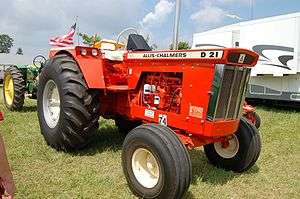
D14
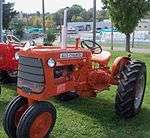
The D14 was the first D-series model, introduced in 1957 and rated at 34.08 belt and 30.91 drawbar horsepower. The D14 had a 14-US-gallon (53 L) gas fuel capacity, and 22.3-US-gallon (84 L) propane fuel capacity. The D14 was made from 1957 to 1960, when it was replaced by the D-15. 17,474 units were made. The D14 weighed about 3,880 pounds.[1]
D15
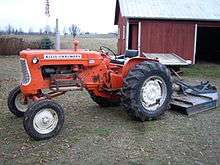
The early D15 was essentially the same as the D14 with the same engine but a higher compression ratio and increased RPMs. The option of power steering was also made available. At serial number 9001 a larger engine was introduced, as well as a few other minor improvements. The D15 had a 16-US-gallon (61 L) fuel capacity for gas and diesel, and a 15.75-US-gallon (59.6 L) capacity for LP gas. 17,434 units were built during their production from 1960 to 1969, with a price of $3,000 in 1967.[2]
D17
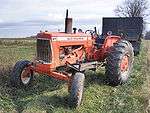
October 1957, the D-17 was introduced, followed by the D10 and the D12 in 1959, in which year Allis-Chalmers made as many as 50 model configurations of the D10, 12, 14, and 17. The D17 was made in gas, diesel, and LPG versions, its 226-cubic-inch engine turned 1,650 rpm, and was tested at 52.6 belt and 46 drawbar horsepower. 62,540 D-17s were produced during their 10-year run. The diesel D17 had a six-cylinder engine with 262 cubic in. and weighed about 4,660 pounds.[3]
D10
.jpg)
The D10 replaced the Model B and were not made with narrow front-ends. Their wide front ends were adjustable. Both models (D10 and D12) were tested at 28.5 belt and 25.8 drawbar horsepower and had 138.7 cubic-inch engines; the only difference between the two was that the D12 had longer front-axle sleeves and a wider front axle adjustment for wider rows. 5,304 D10s were made from 1959 to 1967.[4]
D12

The D12 replaced the Model CA in 1959. 4,070 D12's were made in their 10-year run from 1959 to 1968. The D12 had a 138.7-cubic-inch, four-cylinder, 31-horsepower gasoline engine that was tested in Nebraska at 29.43 drawbar horsepower.[5]
D19
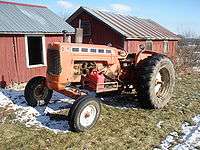
The D19 was introduced in 1961 to suit the needs of larger farmers. It was the first D-series tractor besides the diesel D17 to have a six-cylinder engine. Its horsepower was: 71.54 gas; 66.19 propane, and 66.92 diesel. Its displacement was 262 cubic inches. The diesel model was the first in the industry to come standard with a turbocharger, boosting both horsepower and fuel economy. 10,591 units were built, and they weighed 6650 to 6840 pounds. The D19 was manufactured until 1964. D19s were known for running smoothly and fairly quietly.[6] [7]
The D19 was popular among larger farmers in the 1960s, who had a higher acreage to manpower ratio than ever before. The D19 was able to pull a five bottom plow. It also came in a high-crop version with over three feet (37 inches) of ground clearance.[8]
D21
The D21 was introduced in 1963, and was the largest of the D series, as well as the first Allis-Chalmers tractor to exceed 100 horsepower and the largest row crop tractor available in the industry; rated at 103 horsepower with a 7.0 liter engine.[9] The D21 was styled significantly different than the other D series with full fenders, a large platform, and a rear-mounted fuel tank which held 52 US gallons (200 L), allowing an average of 10 hours of field work. The D21 was not turbocharged until 1965, which pushed its horsepower up to about 128 as it remained the largest row crop tractor available. This gave the D21 over 15,000 pounds of pull, making it the largest tractor Allis-Chalmers had ever made, as well as the most expensive at around 10,000 dollars.[8]
Before this move to turbo, the D21 series I found itself outmoded by the Allis-Chalmers 190XT, which could be turned up to produce more power than the D21. The D21 was replaced in 1970 by the model 220, also with a 7 liter engine, which was rated at 130 horsepower. The D21 was a favorite for tractor pullers and still makes good showings at the pulls today. [10]
See also
| Wikimedia Commons has media related to Allis-Chalmers D series. |
References
- "Allis Chalmers D14 tractor information". Tractordata.com. 2012-05-10. Retrieved 2013-12-12.
- "Allis Chalmers D15 tractor information". Tractordata.com. 2012-05-10. Retrieved 2013-12-12.
- "Allis Chalmers D17 tractor information". Tractordata.com. 2012-05-10. Retrieved 2013-12-12.
- "Allis Chalmers D10 tractor information". Tractordata.com. 2012-05-10. Retrieved 2013-12-12.
- "Allis Chalmers D12 tractor information". Tractordata.com. 2012-05-10. Retrieved 2013-12-12.
- "Allis Chalmers D19 tractor information". Tractordata.com. 2012-12-02. Retrieved 2013-12-12.
- "Welcome to Classic Farm and Tractor | Sample Article". Tractorshop.com. 2010-04-01. Archived from the original on 2012-02-20. Retrieved 2013-12-12.
- "Allis-Chalmers Tractors and Crawlers - Terry Dean - Google Books". Books.google.com. Retrieved 2013-12-12.
- "Allis Chalmers D21 tractor information". Tractordata.com. 2012-12-02. Retrieved 2013-12-12.
- "D-21". Toytractorshow.com. 2000-04-27. Retrieved 2013-12-12.
- Vintage Farm Tractors by Ralph W. Sanders Google Book Result